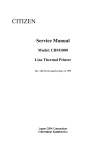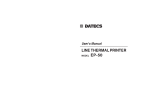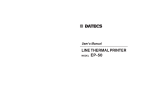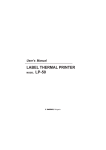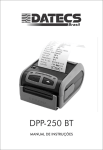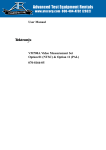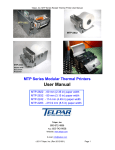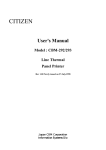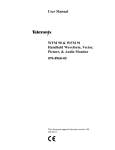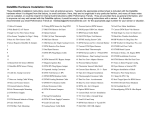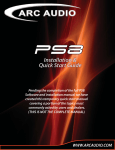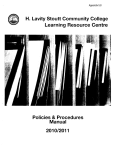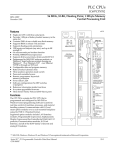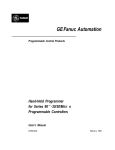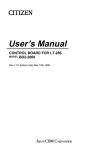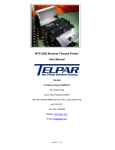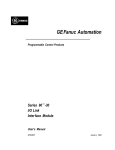Download 1 DATECS
Transcript
1 DATECS User’s Manual ESC/POS PRINTER MODEL EP-1000 CONTENTS ÏÏÏÏÏÏÏ ÎÎÎÎÎÎÎÎÎÎ Î ÎÎÎÎÎÎÎÎÎ ÏÏÏÏÏÏÏ ÏÏÏÏÏÏÏÏÏÏÏÏ 1. ÎÎÎÎÎÎÎÎÎÎ 1. ÎÎÎ ÎÎÎÎÎÎÎÎÎÎÎÎÎÎ ÎÎ ÎÎÎÎÎÎÎÎÎÎ,ÎÎÎÎÎÎÎÎÎ ÎÎÎÎÎÎÎÎÎÎ ÎÎÎÎÎÎÎÎÎÎÎÎÎÎ ÎÎÎÎÎÎÎÎÎ ÎÎÎÎÎÎÎÎÎ ÎÎÎÎÎÎÎÎÎÎ ÎÎÎÎÎÎÎÎÎÎÎ ÎÎ ÎÎÎÎ. ÎÎÎÎÎÎÎ ÎÎÎÎÎÎÎÎÎ ÎÎÎ ÎÎÎÎÎÎÎÎÎ, Î ÎÎÎÎÎÎÎÎÎÎÎÎÎÎÎ ÎÎÎÎÎÎÎÎÎÎÎÎ ÎÎ. 1. GENERAL OUTLINE ............................................................................ 9 1.1 Features ....................................................................................... 9 1.2 Unpacking .................................................................................. 10 1.3 Basic Specifications .................................................................. 11 2. EXPLANATION OF PRINTER PARTS ............................................... 12 2.1 Top View ..................................................................................... 12 2.2 Bottom View ............................................................................... 12 3. PREPARATION ................................................................................. 13 3.1 Connecting the AC Adapter and AC Power Cord ....................... 13 3.2 Connecting Interface Cables ..................................................... 14 3.3 Connecting the Cash Drawer or External Display .................... 14 3.4 Adjusting the Paper Near-end Sensor ...................................... 15 3.5 Partition for 58-mm Wide Paper Roll ........................................ 16 3.6 Setting DIP Switches ................................................................. 17 4. MAINTENANCE AND TROUBLESHOOTING ................................... 18 4.1 Setting/Replacing Paper Rolls .................................................. 18 4.2 Removing Jammed Paper ........................................................ 20 4.3 Cleaning the Print Head ............................................................ 20 4.4 Self-test printing ......................................................................... 21 4.5 Operation Panel and Error Indication ........................................ 22 4.6 Specifications of Drawer Kick-Out Connector & External Display ..................................................................... 24 4.7 Specifications of the power Connector ..................................... 25 5. COMMAND LIST ............................................................................... 26 THE INFORMATION IN THIS DOCUMENT CANNOT BE REPRODUCED IN ANY MECHANICAL, ELECTRICAL OR ELECTRONIC WAY AND UNDER ANY CIRCUMSTANCES WITHOUT THE WRITTEN CONSENT FROM DATECS LTD. Sofia 1784 - BULGARIA, tel: +359 2 974 00 55, fax: +359 2 974 11 00, e-mail: [email protected] http://www.datecs.bg VERSION 1.04 / december 2007 / EN 6. DETAILED DESCRIPTION ............................................................... 28 User’s Manual 1 DATECS EP-1000 2. ÎÎÎÎ ÎÎÎÎÎÎ 2. ÎÎÎÎÎÎÎÎÎ PRECAUTIONS FOR HANDLING ÎÎÎÎÎÎÎÎÎÎÎÎÎÎÎÎÎ Observe the following precautions to use the EP-1000 Printer correctly and avoid troubles from occurring. 3. ÎÎÎÎÎÎÎÎÎ ÎÎ 3. ÎÎÎÎÎÎÎÎÎ • Do not use any other power supply than the specified AC adapter. • Do not allow the printer to start printing when there is no recording ÎÎÎÎÎÎÎÎÎÎÎÎÎÎ, paper installed. • Be careful not to drop foreign substances, such as paper clips, pins or ÎÎÎÎÎÎÎÎÎÎ ÎÎÎÎÎÎÎÎ ÎÎÎÎÎÎÎÎÎÎÎÎÎÎÎÎÎ. ÎÎÎÎÎÎÎÎÎ ÎÎ ÎÎÎÎÎÎÎÎÎ ÎÎÎÎ ÎÎÎÎÎÎÎÎÎ ÎÎÎÎÎÎÎÎÎÎÎÎÎ ÎÎ ÎÎÎÎÎÎ Î screws, into the printer. • Do not spill any liquid on the printer, or spray it with any chemical containing liquid. Do not stamp on, drop, hit, or impart any strong shock to the printer. • • Never use any pointed object such as a pen, to operate the controls • “IIIAI IIA?AOI?E” ÎÎÎÎÎÎÎÎÎÎÎÎÎÎ ÎÎÎÎÎÎÎÎÎÎÎÎÎ ÎÎÎÎÎÎÎÎÎÎÎÎÎÎ ia eanaoa ÎÎ ÎÎÎÎÎÎÎÎÎÎÎÎÎ • • on the operation panel. Do not use cellophane tape to join the ends of paper to allow continuous printing. Never pull the end of the paper installed forcibly with the printer cover left closed. When opening/closing the cover, be careful that the paper does not get caught. ?aaioeee ÎÎÎÎÎÎ To prevent injuries and associated damages: io 8 ÎÎÎÎÎÎÎÎÎ • Do not touch the printing part of the print head. • While the printer is turned on, never touch the moving parts inside, such as the cutter, gears, and electrical parts. ÎÎÎÎÎÎÎÎÎ. • Be careful to avoid bodily injuries or damaging other objects with edges of sheet metal parts. • Should any abnormal condition occur while the printer is operating, Î ÎÎÎÎÎ ÎÎÎÎÎÎÎÎÎÎÎ ÎÎ 1. ÎÎÎÎÎÎÎÎ 1. ÎÎÎÎÎÎÎÎÎÎ Î • ÎÎÎÎÎÎÎÎ ÎÎÎÎÎÎ ÎÎÎÎÎÎÎ ÎÎ ÎÎÎÎÎÎÎ 4 ÎÎÎÎÎÎÎÎÎÎÎÎÎÎÎÎ ÎÎ ÎÎ ÎÎÎÎÎÎ Î • stop it immediately and disconnect the power plug from the wall outlet. When opening/closing the cover, and so on, be careful not to catch your hand or finger on the equipment. Do not try to disassemble and repair the printer on your own. 5 User’s Manual 1 DATECS EP-1000 In the position indicated below, a label is provided to alert your attention. Read the cautionary information on it, and handle the printer properly. This label alerts you to the print head as it becames HOT, and if you touch it, you may get burnt. DAILY MAINTENANCE • Prior to start maintenance work, be sure to turn off the printer. • When cleaning the platen, use a cotton swab applied with ethyl alcohol and wip off stains. CAUTION Avoid cleaning the print head immediately after printing is finished. The print head is HOT. • Use a dry soft cloth to wipe off stains and dust from the surfaces of the printer covers. • When wiping clean heavily stained areas, use a cloth which should be dipped in water and then wrung strongly. Never use organic solvents, such as alcohol, thinner, trichlene, benzene, ketone, or chemical dusters. • If the printer is contaminated with paper dust, use a soft brush to wipe off. HOT AREA: Be careful not to touch this area to avoid burns as it becomes HOT. 6 7 User’s Manual 1 DATECS EP-1000 DAILY MAINTENANCE Cleaning the print head 1 2 3 Turn off the power of the printer. 1. GENERAL OUTLINE This manual describes the general outline, preparations, maintenance & troubleshooting of the ESC/POS printer EP-1000. Also it includes command list and detailed description of the commands. Open the printer cover. Using a gauze impregnated with a small amount of alcohol, wipe off stains and dust on the heat-emitting surface of the head. 1.1 Features The EP-1000 is a line thermal printer which can be used in different applications like communication terminals, ESC/POS terminals & networks and more. ESC/POS printer Compact design Low-noise printing Use of 80 mm - or 58 mm wide paper is available. Auto cutter mechanism provided as a standard unit Built-in input buffer Bar code printing High-speed printing at 100 mm/s max. Built-in Interface for External Display Power supply - AC adaptor Built-in Drawer Kick-out interface CAUTION Avoid cleaning the print head immediately after printing is finished. The print head is HOT. Do not touch the heat-emitting surface of the head with bare hands or metal objects. 8 9 User’s Manual 1 DATECS EP-1000 1.2 Unpacking 1.3 Basic Specifications When unpacking the printer, confirm that the following are provided: Item Specifications Printing Method Printer Printing Width Dot Density Paper Feed Pitch Printing Speed Number of print columns Line thermal print method KF2003-GD30C 52mm, 416 dots (76mm, 608dots) 8 dots/mm (Horizontal/Vertical) 0.125mm Max speed 100 mm/sec 50 / 34 columns (font A) 66 / 45 columns (font B) Font A : 12 x 24 Font B : 9 x 16 Code39, Code93, EAN13, EAN8, UPC-A, UPC-E, Interleaved 2 of 5, Codabar, Code 128 Thermal roll paper 58 mm or 80 mm, ∅ 60 mm or 83 mm 60 - 65 µm Printer .............................................................................. 1 unit Partition (For 58 mm wide paper roll) ............................. 1 piece AC adapter ..................................................................... 1 piece AC power cord ............................................................... 1 piece Sample paper roll (Paper width 80 mm) ........................ 1 piece User’s manual (This book) ............................................. 1 piece ÎÎÎÎÎÎ nuiauaiea “1”, a ia Character size ÎÎÎÎÎÎÎÎ ÎÎÎÎÎÎ Bar Code Types Paper ÎÎÎÎÎÎÎ ÎÎ ÎÎÎÎÎÎÎÎÎ: Paper Thinckness Interface “I?aiueaaia ia iaiaooa” 2. ÎÎÎÎÎÎÎÎÎÎÎ 2. ÎÎÎÎÎÎÎÎ ÎÎ MCU Input Buffer Power Consumption ÎÎÎ ÎÎÎÎÎÎÎÎÎÎ ÎÎÎÎÎ ÎÎÎÎÎÎÎÎÎÎÎ ÎÎÎÎÎÎ Adaptor Indication CAUTION • • • • 10 Install the printer on a flat, sturdy table. Do not install the printer near a heater or in a place exposed to direct sunlight. Do not use the printer in a high-temperature, high-humidity, or heavily contaminated environment. Do not use the printer in an environment where condensation may occur. If condensation should occur, leave the power turned off until condensation evaporates completely. Weight External Dimensions Operating Temperature and Humidity Storage Temperature and Humidity Reliability RS-232 Interface, type RS-232C, max 115200bps Winbond (W77E58P-40) - 8 bits microcontroller 32K bytes 50W max Model: 32AD Input: AC 100 - 240V , 1.3A , 50/60Hz Output: DC 24V, 2A Green LED - Power Red LED - Error (cutter error, head overheat, open cover) Approx. 2 kg 190(W)mm X 145(D)mm X 114(H)mm 5~40°C 35~85%RH -10~60°C 10~90%RH Print head life: 100 million pulses and 100km wear resistance Printer Mechanism: 10 million lines Auto Cutter Life: 500 000 cuts 11 User’s Manual 1 DATECS EP-1000 2. EXPLANATION OF PRINTER PARTS 3. PREPARATION 2.1 Top View 3.1 Connecting the AC Adapter and AC Power Cord 1 Turn off the printer power. 2 For the AC adapter type only: With the flat side of the AC adapter’s cable connector facing upward, insert the cable connector into the power connector on the back side of the printer. 3 Connect the AC power cord to the AC adapter, and insert the AC-power-cord plug into a suitable wall outlet. CAUTION 2.2 Bottom View 12 Do not use any AC adapter other than specified. When connecting or disconnecting the cable connector of the AC adapter, always pull on the connector, not on the cable. The AC power cord should be connected to a wall outlet separated from others used by other equipment which tend to emit noise. Avoid pulling on the power cord, or the cord may be damaged or broken, causing a fire, electric shock. When the thunder rumbles nearby, disconnect the AC power cord from the wall outlet; otherwise, a thunderbolt may cause a fire or electric shock. Avoid placing the power cord near a heating device; otherwise, the cover of the cord may melt, causing a fire or electric shock. When you are not going to use the printer for a long period of time, disconnect the AC power cord from the wall outlet for safety. 13 User’s Manual 1 DATECS EP-1000 3.2 Connecting Interface Cables 3.4 Adjusting the Paper Near-end Sensor 1 Turn off the power of 1 2 Open the printer cover. 3 The following table shows the relationship between adjustment positions and levels of paper roll remaining. (A rough guide) the printer. (As well as the host computer connected) 2 Orienting the interface cable terminal correctly, insert it into the interface connector. Push the sensor knob in the direction of arrow 1 to disengage its claw (Or unlock the sensor unit), and then adjust the sensor unit to a desired paper remaining position within the range shown by arrow 2. 3 Connect the other end of the interface cable to the host computer. 3.3 Connecting the Cash Drawer or External Display 1 Turn off the power of the printer. 2 Orienting the Drawer Drawer Kick-Out /External Display Connector Kick-Out/External Display Cable Connector correctly, insert it into the Drawer Kick-Out/ External Display Connector on the back of the printer. Adjustment position the ground wire to 3 Fasten the ground connector on the printer with a screw. CAUTION 1 φ18 2 φ21 3 φ24 4 φ27 * When specified paper rolls are used. Drawer Kick-Out /External Display cable Connector Do not connect any other device than the specified drawer (Solenoid) to the Drawer Kick-Out Connector. (Do not connect a telephone line either.) 14 Level of paper remaining (Paper roll outside dia. mm) CAUTION Use the level of paper remaining (Paper-roll outside diameter) just as a guide as it varies depending on the particular printer and paper rolls used. 15 User’s Manual 1 DATECS EP-1000 3.5 Partition for 58-mm Wide Paper Roll 1 Turn off the power of the printer. 2 Open the printer cover. 3 Fit the partition supplied into the position shown. 3.6 Setting DIP Switches 1 Turn off the power of the printer. 2 Open the printer cover. 3 Remove the paper roll. 4 While pulling the tab of the DIPswitch cover (To unlock it), lift out the cover. Select Baud Rate 16 Sw1 Sw2 Sw3 Baud Rate (bps) OFF OFF OFF 1200 ON OFF OFF 2400 OFF ON OFF 4800 ON ON OFF 9600 OFF OFF ON 19200 ON OFF OFF ON ON ON 38400 57600 ON ON ON 115200 Switch OFF ON Sw4 Hardware protocol XON / XOFF protocol Sw5 Standard commands Extended commands Sw6 Enables ESC t command Disables ESC t command Sw7 Disable the auto-cutter Enable auto-cutter Sw8 Narrow paper mode (57 mm) Wide paper mode (80 µµ) 17 User’s Manual 1 DATECS EP-1000 4. MAINTENANCE AND TROUBLESHOOTING 4.1 Setting/Replacing Paper Rolls 1 Turn on the printer. 2 Push the ejector in the direction shown to unlock the printer cover. 6 Remove an excess length of paper with the tear bar. (Manual cutter) ÎÎÎ ÎÎÎÎÎÎÎÎÎ Î ÎÎÎÎÎÎÎ 1. ÎÎÎÎÎÎÎÎÎÎ ÎÎÎÎÎÎÎ ÎÎ ioia?aoaa nuiauaiea: 2. ÎÎÎÎÎÎ Î “ÎÎÎÎÎÎÎÎÎÎÎÎÎÎÎÎÎÎÎÎÎÎÎ 3 Placing your hands on both sides of the printer cover, open it until it comes to a stop. ÎÎÎÎÎÎÎÎ ÎÎ ÎÎÎ ÎÎÎÎÎÎÎÎÎÎÎ ÎÎÎÎÎÎ ÎÎÎÎÎÎÎÎÎÎÎÎ ÎÎÎÎÎ RAM NXXX”, Î ÎÎÎ OI na ÎÎÎÎÎÎÎ ÎÎÎÎ, Î ÎÎÎÎÎ ÎÎ CAUTION 4 Check the winding direction of the paper roll, and then place it into the paper roll holder correctly. 5 With the end of the paper approx. 5 cm out of the case of the printer, close the printer cover. Push lightly on the printer cover until a “click” is heard. 18 Always use the specified types of paper roll. Use of other types of paper roll may not be able to guarantee the specified print quality or service life of the printer. When opening the printer cover, do not apply an excess force to it beyond its stop position. The print head has become hot immediately after printing. Do not touch it with your hand. During printing, do not open the printer cover. During printing, do not hold the end of the paper printed and ejected, or paper jam may occur. 19 User’s Manual 1 DATECS EP-1000 4.2 Removing Jammed Paper 4.4 Self-test printing 1 Turn off the power of the printer. 2 Open the printer cover. 3 Remove the paper jam including any paper chips remaining. (Also take If EP-1000 is already switched on - Turn the printer power off. Hold the FEED switch,then turn the printer power on.After about 1 second, the printer starts self-test printing - some diagnostic information for model name,DIP switches setting, baud rate, firmware verton and more. out the paper roll from the holder.) 4 Close the printer cover. 5 Turn on the printer. The auto cutter mechanism is initialized and the alarm is cleared. 4.3 Cleaning the Print Head 1 Turn off the power of the printer. 2 Open the printer cover. 3 Wipe off stains, such as dust and the like, on the heating element of the head using a cotton swab impregnated with ethyl alcohol. 20 } Font size (symbol per line) } Font style } Symbols } } Barcode Some information (FIRMWARE VERSION, to by printing Head, configuration DIP switches, baud rate, protocol, ) 21 User’s Manual 1 DATECS EP-1000 4.5 Operation Panel and Error Indication 4.5.1 OPERATION PANEL 4.5.2 ERROR INDICATION Paper end Paper empty is detected in two steps: paper near-end and paper end. It causes the ERROR LED blinks 1 time per sec.. If paper end is detected, refill the paper. POWER LED (Green) Lights when the power is turned on. ÎÎÎÎÎÎÎÎÎ ÎÎÎÎÎÎ ÎÎ Paper cover open During printing, do not open the paper cover. If you open the paper cover accidentally, the ERROR LED lights. Confirm the paper and close the over. Printing resumes automatically. ÎÎÎÎÎÎÎÎÎÎÎÎÎÎÎÎÎÎ ÎÎÎÎÎ ÎÎ ÎÎÎÎÎÎÎÎÎÎÎ: ÎÎÎÎÎÎÎÎÎ ÎÎÎÎ ÎÎÎÎÎÎÎÎÎÎÎÎÎ ÎÎÎÎÎÎÎÎÎ. “Inoaaao iua: NN io?aoa”, ÎÎ ÎÎ Î ÎÎÎÎÎÎÎÎÎ ÎÎÎÎÎÎÎÎÎÎÎ ÎÎÎÎÎ ÎÎ ÎÎ. ÎÎÎÎÎÎ nn Î ÎÎÎÎÎ ÎÎ Thermal head overheat When you print dense characters or dark image, the head temperature rises. If the head temperature exceeds a specified level, the printer stops printing operation and waits till the head temperature is lowered. During waiting, the POWER LED blinks. When the head temperature is lowered, printing resumes automatically. ÎÎÎÎÎÎÎÎ ÎÎ ÎÎÎ ÎÎÎÎÎÎÎÎÎÎÎ ERROR LED (Red) Lights or blinks to show different error status. Feed switch Status Power LED ERROR LED Paper end Lights Blinks 1 time per sec. Paper near end Lights Blinks 1 time per sec. Cover open error Lights Lights Head Overheat error Blinks Not Lights Pressing this swit6ch briefly causes one line of paper feeding. Holding down the switch causes continuous paper feeding. 22 23 User’s Manual 1 DATECS EP-1000 4.6 Specifications of Drawer Kick-Out Connector & External Display 4.6.1 ELECTRICAL HARACTERISTICS • Drive voltage: DC 24 V • Drive current: 1 A max • SW signal: Signal level “L” = 0 to 0.5 V 4.7 Specifications of the power Connector The following shows the power connector from the dedicated AC adapter. Pin configuration of Power connector (Pin number and function) “H” = 3 to 5 V 4.6.2 CONNECTOR PIN CONFIGURATION No. Signal Definition 1 VDR Drawer drive power supply 2 GND Common ground 3 GND Common ground 4 TXD Display Data to external display 5 DRAWER Drawer drive signal (output) 6 µpen Drw Drawer open signal (input) Power connector: TCS7960-53-2010 (Hosiden) Connector used: 6P6C 4.6.3 DRIVE CIRCUIT 24 25 User’s Manual 1 DATECS EP-1000 5. Command List 1 2 3 4 5 6 7 8 9 10 11 12 13 14 15 16 17 18 19 20 21 22 23 24 25 26 27 28 29 30 31 32 26 BEL HT LF CR ESC RS ESC SP ESC # ESC $ ESC % ESC & ESC ! ESC * ESC ESC . ESC , ESC 2 ESC 3 ESC 8 ESC 9 ESC = ESC > ESC @ ESC D ESC E ESC G ESC I ESC J ESC M ESC R ESC V ESC X ESC Y Sounds the beeper Horizontal tab command Printing and paper feed Print command Sounds the beeper Setting the right space amount of the character Setting the Euro symbol position Specifying the absolute positions Selecting user character set Define user characters Collective specifying printing mode Specifying the bit image mode Specifying/cancelling underline Self test / demo Printing diagnostic information Specifying 1/6-inch line feed rate Setting line feed rate of minimum pitch Temporary store current print settings Restore saved printer settings Data input control Set Factory Defaults Initializing the Printer Setting horizontal tab position Specifying/cancelling highlighting Specifying/cancelling double printing Specifying/cancelling italic printing Printing and feeding paper n/203 inch Selecting character font A or B Setting the international character set Specifying/canceling 90°-right-turned characters Select maximal printing speed Selecting intensity level 07H 09H 0AH 0DH 1BH 1EH 1BH 20H n 1BH 23H n 1BH 24H n1 n2 1BH 25H n 1BH 26H m n1 n2 1BH 21H n 1BH 2AH m n1n2[d]k 1BH 2DH n 1BH 54H 1BH 32H 1BH 33H n 1BH 38H 1BH 39H 1BH 3DH n 1BH 3EH n 1BH 40H 1BH 44H [n]k 00H 1BH 45H n 1BH 47H n 1BH 49H n 1BH 4AH n 1BH 4DH n 1BH 56H n 1BH 59H n 33 34 35 36 ESC Z ESC \ ESC _ ESC ‘ 37 1BH 5AH 1BH 5CH n1 n2 1BH 5FH ESC a Transmits identification string Specifying the relative positions Restore factory settings Transmits current battery voltage and the print head temperature Aligning the characters 38 39 40 41 42 43 44 45 ESC c5 ESC d ESC i ESC m ESC p ESC t ESC v ESC x Enabling/disabling the panel switches Printing and feeding the paper by n lines Cutting the paper Cutting the paper Generating a drawer-kick pulse Selecting the character code table Transmitting the printer status Reversing the print direction 1BH 63H 35H n 1BH 64H n 46 47 48 ESC { GS ( A GS B 1BH 7BH n 49 50 51 GS L GS V GS k Specifying/canceling the inverted characters Printing a self-test Specifying/canceling the black/white inverted printing Setting the left margin Cutting the paper Printing the barcode 52 GS w 53 54 55 56 57 58 59 60 61 62 63 1BH 60H 1BH 61H n 1BH 76H n 1BH 78H n 1DH 4CH n1 n2 1DH 6BH n [d] GS h GS H GS f GS p GS v 0 Selecting the horizontal size (scale factor) of barcode Selecting the height of the barcode Selecting of print position of HRI code Selecting the font of HRI code Setting barcode PDF-417 parameters Printing of raster bit image 1DH 77H n 1DH 68H n 1DH 48H n 1DH 66H n 1DH 70H GS * GS / GS : GS ^ FS p FS q Defining the downloaded bit image Printing the downloaded bit image Starting/ending macro definition Executing the macro Printing the downloaded NV bit image Defining the downloaded NV bit image 1DH2An1n2[d]n1xn2 1DH 2FH m 1DH 3AH 1DH 5EH n1 n2 n3 1CH 70H n m 1CH 71H n xL xH yL yH [d] 27 User’s Manual 1 DATECS EP-1000 6. Detailed Description 5. ESC RS Sounds the beeper 1. BEL Sounds the beeper [Code] [07h] [Outline] Sounds the beeper. [Code] [1Bh] + [1Eh] [Outline] Sounds the beeper. 6. ESC SP n Setting the right space amount of the character 2. HT [Code] [1Bh] + [20h] + n Horizontal Tab Command [Range] {0 <= n <= 20h} [Code] [09h] [Outline] The rightward space amount is set in dot unit (1/203 inch unit). [Outline] Shifts the printing position to the next horizontal tab position. • Ignored when the next horizontal tab position has not been set. • The horizontal tab position is set by ESC D. • Initial setting of the horizontal tab position is each 8 characters in 9th, 17th, 25th, columns. ESC D [Caution] The rightward space amount in double wide mode is made double of the set volume. n=0 [See Also] [Default] 7. ESC # n Setting the Euro symbol position 3. LF Printing and Paper Feed Command [Code] [0Ah] [Outline] Prints data inside the input buffer and feeds lines based on the line feed amount having been set. The head of the line becomes the next print starting position. [See Also] ESC 2, ESC 3 4. CR Print Command [Code] 28 [0Dh] This command is ignored. [Code] [1Bh] + [23h] + n [Range] {0 <= n <= FFh} [Outline] This command is provided because most of the old OEM/DOS code ... pages do not have the euro symbol mapped. This command shows the direct position of the euro symbol in the code table. If n is given value less than 20h the Euro symbol will not be shown. [Caution] When the code page is changed the Euro symbol position is cleared! . The Euro symbol position must be re-entered any time the code page is changed (see below). Any symbol of the code table could be remapped, with no restrictions. The user must take care not to remap some of the most commonly used symbols. Some of the code pages supported by the printer (Windows code ..... pages) include the Euro symbol, using the command in such case will result in Euro symbol appearing twice in the code table. Code pages 20, 21, 22 and 23 (CP858, CP852 + Euro, CP808 and CP857 + Euro) are not hard-coded code pages, i.e. they do not have the Euro Symbol built in. They are produced by giving the Euro symbol position 29 User’s Manual 1 DATECS EP-1000 the proper value. If the command is used with some of these pages the Euro symbol position will be changed, i.e. it will not appear twice. The command ESC > stores the Euro symbol position for further use as a default value. [Default] n = 0 (Not selected) if code page = 20 (CP858), n = D5h; if code page = 21 (CP852 + Euro), n = AAh; if code page = 22 (CP808), n = F2h; if code page = 23 (CP857 + Euro), n = D5h. 10. ESC & s n1 n2 [a [d] s x a] k ESC & m n1 n2 [ d ] k Define user characters There are two different types of this command selected by switch 5’s position. If switch 5 is OFF: [Code] [1Bh] + [26h] + s + n + m + [a1 + D1] + … + [ am-n+1 +Dm-n+1] [Range] {s = 3} {20h <= n <= FFh} {n <= m <= FFh} {0 <= a <= 12} {0 <= Di <= FFh} 8. ESC $ n1 n2 Specifying the Absolute Positions [Code] [1Bh] + [24h] + n1 + n2 [Outline] [Range] {0 <= n1 <= FFh} {0 <= n2 <= 2} {0 <= n1+n2*256 <= 415} – if narrow paper is used {0 <= n1+n2*256 <= 575} – if wide paper is used The printing start position is specified in the number of dots (1/203 inch unit) from the beginning of line. • The number of dots is divided by 256, whose quotient is taken as n2 and the residual as n1. • Therefore, the printing start position is equal to n1 + n2 x 256 from the beginning of line.. Defines a group of downloaded characters where: „s“ is the number of bytes in vertical direction – always three. „n“ indicates the start character code and „m“ indicates the end character code. To define only one character set n=m. „a“ is the number of dots in horizontal direction. „Di“ is the data to be defined. The number of data for each symbol is s x a. Each symbol defines with three bytes of data in vertical direction ollowed by the next three bytes that define the next one-dot column, etc. The downloaded font is cleared by ESC @ and ESC _ commands and when the printer is switched off. [Default] The default downloaded font is equal to the default character set. However the downloaded font is not reset when the code page is chaged, thus it remains the same as the previous code page. [Outline] [Caution] Specifying beyond the line end is ignored. [Default] The initial value is not specified. [See Also] ESC \ 9. ESC % n If switch 5 is ON: [Code] [1Bh] + [26h] + à + n1 + n2 + D11 + … + D(m-n+1)k [Range] {m = 0-3 Subcommand} {20h <= n1 <= FFh } {n1 <= n2 <= FFh } {k = (n2-n1+1)*48 for m=2 and k = (n2-n1+1)*16 for m=3 } [Outline] Defines a group of user characters. m=0: Copy internal character set A to user character set A (Parameters n1, n2 and d are omitted } m=1: Copy internal character set B to user character set B (Parameters n1, n2 and d are omitted } Select/cancel user defined characters [Code] [1Bh] + [25h] + n • Only bit 0 of n is defined Value 0: Selected Value 1: Not selected [See also] 30 ESC & 31 User’s Manual 1 DATECS EP-1000 m=2:Define character group with ASCII codes between >=n1 and <=n2 for character set A (12x24). Every character is 48 bytes, two bytes for each line. Only the first nibble of the second byte is used. [Caution] double wide and double high characters are consisted. • An underline is attached to the full character width, which, however, m=3: Define character group with ASCII codes between >=n1 and <=n2 for character set B (9x16). Every character is 16 bytes. n1 is the ASCII code of the first and n2 is the ASCII code of the last of (n2-n1+1) consecutive symbols. To define a single symbol n1=n2. d is the data that defines the symbols. Every Font A symbol consists of 48 bytes while every Font B symbol consists of 16 bytes. A Font A symbol is defined left to right, top to bottom, two bytes for each horizontal line, as only the four most significant bits of the second byte are used. Every bit denotes one dot. A bit set to ‘1’ means black dot. The most significant bit is the starting. Every horizontal line of Font B symbol consists of one byte, as the ninth point is always white. The most significant bit is the starting. The user-defined characters are kept after printer off. [See Also] [Default] [See Also] Specifying the Bit Image Mode 11. ESC ! n Collective Specifying Printing Mode [Outline] [Code] [1Âh] + [21h] + n [Range] {0 <= n <= FFh} [Outline] Printing mode is assigned. Each n bit indicates the following: Bit Function 0 Character Font Value 1 Font A Font B 1 Undefined 2 Undefined 3 4 5 High-lighting Double height Double width 6 7 32 Value 0 Canceled Canceled Canceled Canceled [1Bh] + [2Ah] + m + n1 + n2 + D1+ … + Dk {m= 0, 1, 32, 33 bit image mode (See the table below.)} {0 <= n1 <= FFh} {0 <= n2 <= 3} {0 <=d <=FFh) {k = n1 + 256 X n2 (m = 0, 1) {k = (n1+256 X n2) X 3} (m = 32, 33) According to the number of dots specified in n1, n2, specify the bit image of mode m. • The total number of dots printed in the bit image is equal to n1 + (256 x n2). • When bit image data have been input in excess of dot position of one line (384 dots) , the excess data are discarded. • d is bit image data, the bits subject to printing are taken as “1” and those not as “0”. • The bit image modes specified by m are shown as follows: Vertical Direction m Mode Dot Density Dot Density Specified 0 8-dot single density 8 67 DPI 101 DPI Specified 1 8-dot double density 8 67 DPI 203 DPI 384 32 24-dot single density 24 203 DPI 101 DPI 192 33 24-dot double density 24 203 DPI 203 DPI 384 Specified Dots Horizontal Direction Specified Undefined Underline is not attached to the part having been skipped by the horizontal tab. Neither is it attached to 90o-right-turned characters. • The underline width is as having been specified by <ESC - >. (The default setting is 1 dot width) • In case that double wide character and normal character exist in same one line, the layout of underline is consistent one. n=0 ESC E, ESC – 12. ESC * m n1 n2 [ d ] k [Code] [Range] ESC % • With double height and double width being specified simultaneously, Max. Dots 192 33 User’s Manual 1 DATECS EP-1000 [Caution] • When the values set in m (bit image mode) are out of the above range, the data following after n1 is processed as normal printing data. • After completion of bit image printing, printer returns to normal data processing mode. The command has another variant with four new modes: 13. ESC – n Specifying/ Canceling Underline [Code] [1Bh] + [2Dh] + n [Range] {0 <= n <= 2} [Outline] Specifying/canceling an underline. • Types of underlines by n value are shown below: ESC * m n[ d ] k ESC * m n a f [ d ] k 0 Canceling an underline. 1 Specifying an underline for 1-dot width. Specifying the Bit Image Mode (Sending graphics data horizontally) [Code] [1Bh] + [2Ah] + m + n + { a + [00h] } +D1 + … +Dk [Range] {m = 16, 17, 18, 20 bit image mode } {0 <=n <=40h} {0 <= d <= FFh} {k = n * 24 * 48} (m = 16) {k = n * 24 * 48} (m = 17) {After decompression} {k = n * h * 48} (m = 18) {After decompression} {k = n * 24 * 48} (m = 20) After decompression} {0 <= a <= 24 (Used only for mode 18.)} {f = 0 (Used only for mode 18.)} [Outline] [Caution] In these graphics modes is sent a graphics block with variable width n*8 dots and height 24 dots for modes 16,17 and a dots for mode 18. In mode 17 data is compressed, and the bytes count specified is before the compression. In mode 16 the same data is without compression. Mode 20 is similar to mode 17, but every byte is mirrored before putting in the print buffer (bits 0 and 7, 1 and 6, 2 and 5, 3 and 4 change places). All modes are high resolution (203 x 203 DPI). • When bit image data have been input in excess of dot position of one line (384 dots) , the excess data are discarded. • d is bit image data, the bits subject to printing are taken as “1” and those not as “0”. • When the values set in m (bit image mode) are out of the above range, the data following after n is processed as normal printing data. • After completion of bit image printing, printer returns to normal data processing mode. [Compression procedure for mode 17 and 18] A simple RLE encoding like this in PCX files is used. If two most signifi cant bits of the byte are set, the 6 LSB contain a repeat counter (1-63), and the next byte contains the data to be repeated. A single data byte with 2 MSB set must be sent as two bytes. 34 2 Specifying an underline for 2-dots width. [Caution] • An underline is attached to the full character width. It is, however, not attached to the part having been skipped by horizontal tab command. • An underline is not attached to a 90°- right-turned characters. [See Also] ESC ! 14. ESC . Selftest [Code] [1Bh] + [2Eh] [Outline] Prints character table, character samples with different attributes and diagnostic information. [See also] ESC , 15. ESC , Printing diagnostic information [Code] [1Bh] + [2Ch] [Outline] Printing current intensity level, temperature, code tables, communication mode, protocol and serial port speed if a serial communication board is installed. [See also] ESC . 35 User’s Manual 1 DATECS EP-1000 16. ESC 2 20. ESC = n Specifying 1/6-inch line feed rate Data Input Control [Code] [1Bh] + [32h] [Code] [1Bh] + [3D] + n [Outline] The line feed rate per line is specified by 1/6 inch. [Range] {0 <= n <= FFh} [Outline] Selecting equipment in which data input from the host is effective. 17. ESC 3 n • Only bit 0 is defined Value 0: Selected Value 1: Not selected Setting line feed rate of minimum pitch [Code] [Range] [1Bh] + [33h] + n {0 <= n <= FFh} [Outline] The line feed rate per line is specified by n/203 inch. [Default] The initial value is n = 34 (1/6 inch) (22H), being 4.23 mm line feed rate. • When the printer has not been selected, this printer abandons all the received data until it is selected by this command. [Caution] • Even when the printer has not been selected, it can become BUSY state through printer operation. • When the printer is deselected, this printer discards all the data until it 18. ESC 8 is selected with this command. Temporary store current print settings [Default] [Code] [Outline] 21. ESC > n [Caution] [1Bh] + [38h] Use command ‘ESC 9’ to restore the parameters. The parameters stored are: double height/width symbols, rotated by 90º degrees symbols, font size, underline, emphasize, italic style, downloaded font active, rotated by 180o degrees symbols, black and white inverse symbols, reverse print direction (from right to left), Chinese/Arabic code table selected (only in the Chinese/Arabic printer version), print density, printing speed, left margin, printing width, line height, intercharacter space, country, code page, Euro symbol position, barcode width, barcode height, barcode HRI position. The printer uses this command when printing full and short self-tests. So if a self-test is printed, the printer will store the print settings active at the time the printing starts. 19. ESC 9 The initial value of n is “1”. Set Factory Defaults [Code] [1Bh] + [3Eh] + n [Range] {0 <= n <= FFh} [Outline] This command writes the current code tables, the intensity level and the current printing speed into the flash memory. These values will be retrieved at first power up or after a power failure. • Value of n doesn’t matter. It is left for compatibility purpose. [Default] • The initial values are: code tables 0 (US American CP437), intensity level 100%, maximum printing speed. 22. ESC @ Restore saved to nonvolatile RAM settings Restore the previously saved settings [Code] [1Bh] + [40h] [Code] [1Bh] + [39h] [Outline] [Outline] This command restores the setting saved with ESC 8. If such a command has never been issued, the printer restores the settings as they were at printer power on. Clears data stored in the print buffer and brings various settings to the initial state. [Caution] • Data inside the internal input buffer are not cleared. 36 37 User’s Manual 1 DATECS EP-1000 • The current code tables, print intensity and printing speed are not reset. • If switch 5 is OFF, the command clears the downloaded font and bit image too. [See also] ESC ^ and ESC _ 24. ESC E n Specifying/canceling highlighting [Code] [1Bh] + [45h] + n [Range] {0 <= n <= FFh} [Outline] 23. ESC D [ n ] k NUL 0 Canceling highlighting. 1 Specifying highlighting. • This is effective to all characters of font A. • Characters of font B are not highlighted. • Dot configuration of a highlighted character includes one extra dot added at its side. Setting Horizontal Tab Position [Code] [1Bh] + [44h] + n1 + … + nk + [00h] [Range] {0 <= n <= FFh} {0 <= k <= 20h}. [Outline] Specifying a horizontal tab position. • “n” indicates the no. of columns from the beginning to the horizontal tab position. At this time, n= set position 1 is to be specified. For example, to set the position at 9th column, n=8 is to be specified. • “k” denotes the number of horizontal tab positions you want to set. • The tab position is set at position where it is “character width x n” from the line beginning. The character width, at this time, includes the right ward space amount. In double wide characters, it is made double of the ordinary case. • Tab positions can be specified are maximum 32. Specifying exceeding this is ignored. • <n> k, which denotes a setting position, is input in the increasing order and ends at <00>H. • ESC D NUL clears all the set tab positions. Following clearing, horizontal tab command is ignored. [Caution] When the data, <n> k, is equal to or smaller than its preceding data, <n>k-1, it is assumed that tab setting is finished. If this is the case, the next data onward will be processed as normal data. When the data, <n> k, exceeds a 1-line print area, set the horizontal tab position, assuming “Set digit position = Maximum print digits + 1.” The horizontal tab position does not change even if the character width is altered after setting the horizontal tab position. [Default] Initial value is specified for each eight characters(9 th .17 th .25 th column). [See Also] HT 38 Specifying/canceling the highlighting characters. • “n” is valid only for the lowest bit (n0). • Control by the lowest bit (n0) is shown as follows: [Caution] The print result of Double printing and highlight character printing is completely same. [See Also] ESC ! 25. ESC G n Specifying/canceling Double Printing (ESC G n) [Code] [1Bh] + [47h] + n [Range] {0 <= n <= FFh} [Outline] Specifying/canceling the double printing. • “n” is valid only for the lowest bit (n0). • Control by n is shown as follows. 0 Canceling double printing. 1 Specifying double printing. • This is effective to all characters of font A. • Characters of font B are not highlighted. [Caution] The print result of Double printing and highlight character printing is completely same. [See Also] ESCE 39 User’s Manual 1 DATECS EP-1000 26. ESC I n 29. ESC R n Specifying/cancelling italic printing (ESC I n) Selecting international character set [Code] [1Bh] + [49h] + n [Code] [1Bh] + [52h] + n [Range] {0 <= n <= FFh} [Range] {0 <= n <= 10} [Outline] Specifying/canceling the double printing. • “n” is valid only for the lowest bit (n0). • Control by n is shown as follows. 0 Canceling italic printing. 1 Specifying italic printing. [Outline] Depending on the value of „n“, one of the following character sets is selected: 27. ESC J n Printing and feeding paper n/203 inch [Code] [1Bh] + [4Ah] + n [Range] {0 <= n <= FFh} [Outline] Prints data inside the print buffer and feeds paper by n/203 inch. Since an actual mechanical pitch is 1/203 inch, it is internally converted approximate to the value specified with this command. • Specified volume does not remain. • The beginning of the line is to be considered as the next printing start position. • Initial value is not defined. Q &RXQWU\ 86$ )UDQFH *HUPDQ\ 8. 'HQPDUN, 6ZHGHQ ,WDO\ 6SDLQ, -DSDQ 1RUZD\ 'HQPDUN,, &KDUDFWHU6HW K K K %K &K 'K (K K %K &K 'K (K # > ? @ A C ^ _ ` a j A C p q b g h A C l | # > ? @ A C ^ _ ` a # c A C ¡ n a e b g c h p l | n # ? p A j z q u 3W # £ f ¢ A C x ` a # > @ A C ^ _ ` a ͞ e c h p ¡ n e c h p ¡ n 30. ESC V n Specifying/Canceling 90o -right- turned Characters 28. ESC M n [Code] [1Bh] + [56h] + n Specifying/canceling highlighting [Code] [1Bh] + [4Dh] + n [Range] {0 <= n <= 1}. [Outline] Specifying/canceling characters 90o -right- turned character. • “n” means the followings. 0 Canceling 90o -right- turned Characters 1 Specifying 90o -right- turned Characters [Caution] No underlines are attached to 90º -right- turned characters . [Default] The initial value of n is “0”. [Range] [Outline] {0 <= n <= FFh} Selects character font. • “n” is valid only for the lowest bit (n0). • Control by the lowest bit (n0) is shown as follows: 0 Selection of font A (12x24). 1 Selection of font B (9x16). [Caution] ESC ! can also select fonts, but the setting made by the command processed last is valid. [See also] ESC ! 40 41 User’s Manual 1 DATECS EP-1000 1 – 22: Printer name complemented with space up to 22 symbols. 23 – 25: Firmware version – 3 digits (in ASCII format). 26 – 26: Language version – 2 letters. 28 – 32: 5 bytes flags. Each bit describes a printer feature, as ‘1’ means that the feature is present, while ‘0’ means its absence. Bits are described as follows: 31. ESC X n Select maximum printing speed [Code] [1Bh] + [58h] + n [Range] {0 <= n <= 3} {‘0’ <= n <= ‘3’} [Outline] Selects the maximum printing speed according to the value of ‘n’: 0 or ‘0’ about 100 mm/s 1 or ‘1’ about 83 mm/s 2 or ‘2’ about 66 mm/s 3 or ‘3’ about 50 mm/s These values are approximate. The real maximum speed depends on the print intensity and the printing head’s temperature. [Default] The default value is 0 – maximal printing speed. 32. ESC Y n Selecting the intensity level [Code] [1Bh] + [59h] + n [Range] {0 <= n <= 5} [Outline] Set the intensity level. • “n” means the followings. 0 1 2 3 4 5 Set intensity 70 % Set intensity 80 % Set intensity 90 % Set intensity 100 % Set intensity 120 % Set intensity 150 % [Caution] Higher intensities can cause a lower speed. [Default] The initial value of n is 3. 33. ESC Z Transmits identification string. [Code] [1Bh] + [5Ah] [Outline] The printer transmits 32 bytes of information with the following structure: 42 Bit 28.0 28.1 28.2 28.3 28.4 28.5 28.6 28.7 29.0 29.1 29.2 29.3 29.4 29.5 29.6 29.7 30.0 30.1 30.2 30.3 30.4 30.5 30.6 30.7 31.0 31.1 31.2 Meaning Supports IrDA mode Supports magnetic card reader Supports simultaneous reading of three tracks from a magnetic card ASCII codes above 127 contain Katakana symbols Supports JIS and Shift-JIS symbols Prints when ESC . and ESC T, and transmits when ESC ‘ the temperature in º Fahrenheit Not Used Reserved – always 1 Supports downloadable fonts and firmware Korean support Black mark support Bar code reader support USB A installed USB B installed Not Used Reserved – always 1 Not Used Not Used Not Used Not Used Not Used Not Used Not Used Reserved – always 1 Not Used Not Used Not Used 43 User’s Manual 1 DATECS EP-1000 31.3 31.4 31.5 31.6 31.7 32.0 32.1 32.2 32.3 32.4 32.5 32.6 32.7 Not Used Not Used Not Used Not Used Reserved – always 1 Not Used Not Used Not Used Not Used Not Used Not Used Not Used Reserved – always 1 34. ESC \ n1 n2 35. ESC _ Restore factory defaults and save them to nonvolatile RAM [Code] [1Bh] + [5Fh] [Outline] Select font A, no bold, no underline, etc. Restore tab defaults. The parameters are read from the flash memory. Downloaded font and downloaded bit image are cleared. Copy internal fonts A and B to user fonts. DIP switches are read again. Data in the input buffer is not cleared. [See also] ESC @ 36. ESC ‘ Transmits the current power supply voltage and the print head temperature [Code] <1B>H<60>H [Outline] The printer transmits two bytes data. First byte is the power supply voltage given as 0.1 mV plus 20h. the second byte is the print head temperature, in degrees Celsius, plus 20h. Specifying the Relative Positions [Code] [1Bh] + [5Ch] + n1 + n2 [Range] {0 <= n1 <= FFh} {0 <= n2 <= FFh} The printing start position is specified in the number of dots(1/203 inch unit) from the current position. • Rightward direction is taken as plus and leftward direction as minus. • To specify N dot in minus (left) direction, use a complement of N for assignment. – N dots = 65536 – N • The number of dots is divided by 256, whose quotient is taken as n2 and the residual as n1. • There are 416 dots per line (positions from 0 to 415) when in “narrow” paper mode • There are 576 dots per line (positions from 0 to 575) when in “wide” paper mode. Specifying exceeding the beginning of the line or the end of the line is ignored. [Outline] [Caution] [Default] The initial value is not specified. [See Also] ESC $ 44 [Example] If the battery voltage is 6.4 V, and the print head temperature is 33°C, the printer will transmit <60h><41h>, which is <40h+20h><21h+20h> or <64+32><33+32>. 37. ESC a n Aligning the characters [Code] [1Bh] + [61h] + n [Range] {0 <= n <= 2} {4 <= n <=6 } [Outline] This command is extended and has the following format: All the printed text data, the barcode or the raster bit image (GS v0) within one line are aligned in the specified position. If used before printing a barcode with this command can be specified vertical direction for printing the bar code. • Depending on n value, positional alignment is carried out as in the table below: 0 Left end alignment 45 User’s Manual 1 DATECS EP-1000 1 Centering 2 Right end alignment 4 Left end aligned vertical bar code 5 Centred vertical bar code 6 Right end aligned vertical bar code [Default] Enabling/Disabling Panel Switches [Code] [1Bh] + [63h] + [35h] + n [Range] {0 <= n <= FFh} [Outline] Selecting the LF switch valid/invalid. • “n” is valid only in the lowest bit (n0). • “n” bit means the followings. 0 LFSW valid. 1 LFSW invalid. [Default] Cutting the paper [Code] [Outline] The initial value of n is “0”. 38. ESC c5 n [Caution] 40. ESC i When the panel switch is disabled with this command, the LF switch is disabled. Therefore, the paper cannot be fed by operating the LF switch. The initial value of n is “0”. 39. ESC d n [1Bh] + [69h] The command performs a partial cut (one point left uncut). Prior to cutting the paper is fed so the last printed line remains after the cutter’s edge. This command is valid only at the beginning of the line. 41. ESC m Cutting the paper [Code] [1Bh] + [6Dh] [Outline] The command is exactly the same as ESC i. 42. ESC p Generating a drawer-kick pulse [Code] [1Bh] + [70h] + m + n1 + n2 [Range] {0 <= m <= 255} {0 <= n1 <= 255} {0 <= n2 <= 255} [Outline] The value of m is ignored. The printer generates a 2*n1 milliseconds long pulse and 2*n2 milliseconds long rest after the pulse. n2 must be at least four times greater than n1 or the command will be discarded. Printing and Feeding the paper by n lines [Code] [1Bh] + [64h] + n [Range] {0 <= n <= FFh} [Outline] Prints data inside the buffer and feeds paper by n lines. 43. ESC t • Specified line does not remain. • The beginning of the line is to be considered as the next printing start Selecting the character code table position. [Default] 46 The initial value is not defined. [Code] [Range] [Outline] [1Bh] + [74h] + n {0 <= n <= 19} Selects the code table for ASCII codes 80h-FFh. One of the following supported code tables is selected according to the value of n: 47 User’s Manual 1 DATECS EP-1000 n Code Table 0 USA (CP437) 1 Litva 2 West Europe Latin I (CP850) 3 Brasil (CP860) 4 Poland 5 Bulgarian (CP856) 6 Central Europe Latin II (CP852) 7 Russian (CP866) 8 Turkish (CP857) 9 Windows English Latin I (CP1252) 10 Baltic (CP775) 11 Latvia 12 Greek (CP737) 13 Hebrew (CP862) 14 Windows Central European Latin II (CP1250) 15 Windows Cyrilic (CP1251) 16 Windows Greek (CP1253) 17 Windows Turkish (CP1254) 18 Windows Hebrew (CP1255) 19 Windows Baltic (CP1257) 20 West Europe Latin I + Euro (CP858) 21 Central Europe Latin II + Euro (CP852 + Euro) 22 Russian + Euro (CP808) 23 Turkish + Euro (CP857 + Euro) In the Chinese version of the printer one of the following supported code tables is selected according to the value of n: In the international version of the printer when the code page is set by the DIP switches the command is disabled and a code page other than this one cannot be set. In the Chinese version of the printer the code table can be changed regardless of the DIP switch setting. Code pages 20, 21, 22 and 23 (CP858, CP852 + Euro, CP808 and CP857 + Euro) are not hard-coded code pages, i.e. they do not have the Euro Symbol built in. They are produced by giving the Euro symbol position the proper value. If ESC # is used with some of these pages the Euro symbol position will be changed, i.e. it will not appear twice. Even if the code page is set by the DIP switches the command ESC > will store this code page into the flash for further use. The command <ESC t 14h> is equal to the combination of commands <ESC t 02h> + <ESC # D5h>. The command <ESC t 15h> is equal to the combination of commands <ESC t 06h> + <ESC # AAh>. The command <ESC t 16h> is equal to the combination of commands <ESC t 07h> + <ESC # F2h>. The command <ESC t 17h> is equal to the combination of commands <ESC t 08h> + <ESC # D5h>. [Default] The default value is 0 – USA CP437 code page. 44. ESC v Transmitting the printer status [Code] [Outline] Bit [1Bh] + [76h] Current printer status is transmitted.. Status sent out consists of 1 byte whose content is as in the table below. Function 0 Value 0 Value 1 Not defined 1 Not defined 2 Paper end 3 Head temperature With paper Without paper Normal Overheated n Code Table 4 0 USA (CP437) 5 Chinese GB2312 6 Not defined 7 Not defined 1 48 [Caution] Not defined Auto-cutter No error Error (jam) 49 User’s Manual 1 DATECS EP-1000 45. ESC x n 47. GS (A pL pH n m Reversing the print direction Printing a self-test [Code] [1Bh] + [78h] + n [Code] [1Dh] + [28h] + [41h] + pL + pH + n + m [Outline] This command changes the characters’ print direction from left to right to right to left. The character itself is not mirrored horizontally. The command is intended for languages that use right to left scripting, like Hebrew and Arabic. Only the lowest bit of “n” is valid with the following meaning: 0 – left to right printing 1 – right to left printing [Range] {0 <= pL <= 255} {0 <= pH <= 255} {0 <= n <= 255} {2 <= m <= 3} [Outline] This command is intended for compatibility purposes. A “short” or “long” test is printed depending on the value of m. m = 2 – printing a “long” test (ESC .) m = 3 – printing diagnostic information (“short” test) (ESC ,) [Caution] [Default] The command changes only the print direction of the characters - all graphics and bar codes are unaffected. This command is ignored in the Chinese version of the printer. The command reverses all print attributes of the line and the characters, though the characters themselves are not mirrored horizontally. Though the command allows mixing reversed and non-reversed characters in one line the print results could be unsatisfactory and unreliable. 48. GS B n Specifying/canceling the black/white inverted printing [Code] [1Dh] + [62h] + n According to the least significant bit of n (n0) the following modes are possible: n0 = 0 – Black/white inverted printing is canceled n0 = 1 – Black/white inverted printing is specified The space skipped by tab command or by positioning commands (ESC $, ESC \) is not affected. Both built-in and downloaded character sets are inverted by this command. The black/white inversion works on the right space defined by ESC SP command. [Default] The initial value is n=0 The default value is 0 – left to right printing 46. ESC { n Specifying/Canceling the Inverted Characters [Code] [1Bh] + [7Bh] + n [Range] {0 <= n <= FFh} [Outline] Specifying/canceling inverted characters. • “n” is valid only for the lowest bit (n0). • Bit n (n0) means the followings. 0 Canceling inverted characters. 1 Specifying inverted characters. [Caution] [Default] 50 • Inverted printing means printing the line at 180º turned. • Valid is the last value specified in a line. The initial value of n is “0”. 49. GS L n1 n2 Setting the left margin [Code] [1Dh] + [4Ch] + n1 + n2 [Range] {0 <= n1 <= FFh} {0 <= n2 <= FFh} [Outline] Sets the position in dots (1/203 inches) from which each line starts. This command works only if entered at the beginning of the line. The start position is equal to n1+256*n2 dots from the left end of the printable area. 51 User’s Manual 1 DATECS EP-1000 [Caution] If a value that exceeds the length of the print area is set the left margin is set to 0. n1+256*n2 < 416 when a narrow paper is used [Outline] n1+256*n2 > 576 when a wide paper is used [Default] Default value is 0. 50. (1)GS V m (2)GS V m n Cutting the paper [Code] (1) [1Dh] + [56h] + m (2) [1Dh] + [56h] + m + n [Range] (1) {m=1, m=49} (2) {m=66} {0 <= n <= 255} [Outline] Depending on the value of m one of the following actions is performed: - if m=1 or m=49 (‘1’) a partial cut is performed - if m=66 (‘B’) the paper is fed by n/8 mm and then a partial cut is performed In both cases the paper is first fed to the cut position so the last printed line remains after the cutter’s edge. This means that in case (2) the paper is fed by “cut position + n/8” millimeters prior to cutting. 51. (1) GS k m [ d ] k NUL (2) GS k m n [ d ] k (3) GS k m a [ d ] k NUL (4) GS k m a xL xH [ d ] k M (1) 0 1 2 3 4 5 6 7 8 9 (4) {m=74; 256*xH+xL<=3000; a=0,1} Specifying a type of bar code and printing bar codes. • The beginning of line is considered as the next printing start position. • Depending on the value of m, the following bar code can be selected. d indicates a bar code data to be printed and k indicates the number of character to be printed. n indicates indicates number of characters when 65 <= m <= 73. a is a setting for PDF-417 bar code. Setting a=0 will make the printer to automatically choose PDF-417 compression modes, while a=1 will force byte compression mode. xL and xH indicates the number of bytes for PDF-417 bar code when m=74. The number of bytes is equal to 256*xH+xL. m determines bar code type and it is one of the following: Bar code type Length Range of ‘d’ UPC-A 11 48 <= Di <= 57 UPC-E 11 48 <= Di <= 57 EAN13 (JAN13) 12 48 <= Di <= 57 EAN 8 (JAN8) 7 48 <= Di <= 57 CODE 39 48 <= Di <= 57, 65 <= Di <= 90, 32, 36, 37, 43, 45, 46, 47 ITF 48 <= Di <= 57 CODABAR (NW-7) 48 <= Di <= 57, 65 <= Di <= 68, 36, 43, 45, 46, 47, 58 CODE 93 1 <= Di <= 127 CODE 128 1 <= Di <= 127 PDF-417 1 <= Di <= 255 M (2) Bar code type Length Range of ‘d’ 65 UPC-A 11 48 <= Di <= 57 66 UPC-E 11 48 <= Di <= 57 48 <= Di <= 57 67 EAN13 (JAN13) 12 Printing the bar code 68 EAN 8 (JAN8) 7 48 <= Di <= 57 [Code] 69 CODE 39 - 48 <= Di <= 57, 65 <= Di <= 90, 32, 36, 37, 43, 45, 46, 47 70 ITF - 48 <= Di <= 57 71 CODABAR (NW-7) - 48 <= Di <= 57, 65 <= Di <= 68, 36, 43, 45, 46, 47, 58 72 CODE 93 - 0 <= Di <= 127 73 CODE 128 - 0 <= Di <= 127 74 PDF-417 - 0 <= Di <= 255 [Range] 52 (1) (2) (3) (4) [1Dh] + [6Bh] + m + Di + [00h] [1Dh] + [6Bh] + m + n + Di [1Dh] + [6Bh] + m + a + Di + [00h] [1Dh] + [6Bh] + m + a + xL + xH + D (1) {0 <= m <= 6} (2) {65 <= m <= 73} (3) {m=9; a=0,1} 53 User’s Manual 1 DATECS EP-1000 [Caution] • When data being held in the print buffer, this command is ignored. • Regardless of the specified feed pitch, this command feeds the paper 7B, 41 {A CODEB 123, 66 7B, 42 {B CODEC 123, 67 7B, 43 {C system, the bar code so far will be printed, processing the subsequent data as normal data. • When a bar code whose number of characters to be printed is fixed has been selected, the number of characters k have to be always made equal to the number of characters to be printed. (The bar code is not printed when not matching.) • When the horizontal direction exceeds one line length, the bar code is not printed. •The initial value is not specified. SHIFT 123, 83 7B, 53 {S { 123, 123 7B, 7B {{ [CODE 128 additional information] Code 128 covers all ASCII codes from 0 to 127, and it has three tables A, B and C that can be used in the same bar code. Table A: contains ASCII symbols with codes 0 to 95 and control symbols FNC1, FNC2, FNC3, FNC4, SHIFT, CODEB, CODEC. Table B: contains symbols with ASCII codes from 32 to 127 and control characters FNC1, FNC2, FNC3, FNC4, SHIFT, CODEA, CODEC. Table C: It is used for coding bar code areas that consist only of numerals. Each symbol gives two digits that are coded with ASCII codes from 0 to 99. Control characters FNC1, CODEA, CODEB are also available. The bar code must start with one of the symbols CODEA, CODEB or CODEC, that determines which table will be used. If it is necessary the urrent table could be changed later by inserting one of these symbols in to the bar code. The symbol following SHIFT character is considered to be from table B, if table A is current, or from table A, if table B is current. If a symbol that is not valid for the current table is used, the whole bar ode is not printed. Control symbols are assigned two bytes as follows: Symbol 54 123, 65 • If the character code d cannot be printed in the respective bar code hat is required to print a bar code. [Default] CODEA Code system Decimal Hexadecimal Text FNC1 123, 49 7B, 31 {1 FNC2 123, 50 7B, 32 {2 FNC3 123, 51 7B, 33 {3 FNC4 123, 52 7B, 34 {4 52. GS w n Selecting the horizontal size (Scale factor) of the bar code [Code] [1Dh] + [77h] + n [Range] {2 <= n <= 4} [Outline] Selecting bar code width. n denotes the number of dots in fine element width. The initial value of this width is “3” [Default] 53. GS h n Selecting the height of the Bar Code [Code] [1Dh] + [68h] + n [Range] {1 <= n <= FFh} [Outline] Selecting bar code height. n denotes the number of dots in the vertical direction. The initial value of n is “162” [Default] 54. GS H n Selecting of Printing Position of HRI Code [Code] [1Dh] + [48h] + n [Range] {0 <= n <= 3} [Outline] Selecting printing position of HRI code in printing bar codes. • “n” means the followings. 0 No printing 1 Above the bar code 2 Below the bar code 55 User’s Manual 1 DATECS EP-1000 3 Both above and below the bar code EC level EC Codewords Auto Select Level The HRI code refers to the bar code-turned characters so that you can read them. 0 2 [Caution] The HRI code is printed in the font selected with GS f. Specify before the GS k command. 1 4 0-31 2 8 32-63 [Defult] The initial value of n is “0”. 3 16 64-127 [See Also] GS f 4 32 128-255 5 64 256-511 6 128 512-928 55. GS f n 7 256 - Selecting the font of HRI code 8 512 - [Code] [1Dh] + [66h] + n [Range] n = 0, 1 [Outline] Selecting the font of HRI code in printing bar code. The type of font can be printed by selecting n is as follows. 0 Font A 1 Font B The HRI code refers to the bar code-turned characters so that you can read them. [Caution] The HRI code is printed at the position specified with GS h on page 63. [Default] The initial value of n is “0 ”. [See Also] GS H 56. GS p n1 n2 n3 Setting bar code PDF-417 parameters [Code] [Range] [Outline] 56 [1Dh] + [70h] + n1 + n2 + n3 {0 <= n1 <= 255} {0 <= n2 <= 30} {n3=0; 3 <= n3 <= 90} n1 selects PDF-417 security level. Setting a security level higher than eight forces the printer to automatically adjusts the security level ac cording the following table: - • Only real data codewords in the security level calculation (any pad codewords are ignored). n2 – number of data columns. If n2=0 the number of data columns is automatically calculated. n3 – number of rows. If n3=0 the number of rows is automatically calculated. [Caution] If any value is out of range this value remains unchanged. Thus the other values are changed. [Default] The initial value of n1 is “9 ” (auto select). The initial value of n2 is “0 ” (auto select). The initial value of n3 is “0 ” (auto select). [See Also] GS k 57. GS v0 Printing of raster bit image [Code] [Range] [1Dh] + [76h] + [30h] + m + xL + xH + yL + yH + D1 + … + Dn {0 <= m <= 3; 48 <= m <= 51} {0 <= xL <= 255} {0 <= xH <= 255} {0 <= yL <= 255} {0 <= yH <= 255} {0 <= Di <= 255} [Outline] The value of xH is ignored. Although yH could be from 0 to 255 the high four bits are ignored, so yH could actually be from 0 to 15. 57 User’s Manual 1 DATECS EP-1000 xL is the number of bytes in horizontal direction (xL*8 dots). The number of dots in horizontal direction is equal to yL+yH*256. The number of data bytes k=xL * (yL+yH*256). However k must not be equal to 0 or the bit image will be discarded. m defines the printing mode of the bit image according to the following table: m Mode Dot density in vertical direction Dot density in horizontal direction 0 Normal 203 DPI 203 DPI 1 Double width 203 DPI 101 DPI 2 Double hight 101 DPI 203 DPI 3 Quadruple 101 DPI 101 DPI This command defines a bit image with number of dots determined by n1 and n2. There are n1*8 dots in horizontal direction and n2*8 number of dots in vertical direction. If n1 is 0 the downloaded bit image is cleared. The command GS / is used to print downloaded bit image. If switch 5 is ON: [Code] [1Dh] + [2Ah] + n1 + n2 { + n21 + n22 } + D1 + … + DN [Range] {0 <= n1 <= 7Fh} {0 <= n2 <= F8h} {0 <= Di <= FFh} {1 <= n21+256*n22 <= 272} [Outline] If n2 is 0 two more bytes are read. These two bytes then determine the vertical size of the bit image. The vertical size then is N= n21+256*n22 rows. If N is the vertical size of the bit image, N=n2 or N= n21+256*n22. Di is the bit image’s data. The number of data bytes is n1*N. There are n1 bytes in the first row then n1 bytes in the second, etc. There are N rows in the bit image, and the number of dots in the bit image is n1*N*8. Each data bit defines one dot, value of “1” corresponds to black. If n1 is 0 the downloaded bit image is cleared. The downloaded bit image remains effective even if the printer is switched off. [See Also] GS / The bit image is defined line by line from left to right. The most significant bit of each byte is the leftmost dot and the least significant bit is rightmost dot. The data that exceeds the printing width of the line is discarded. The raster bit image could be positioned using the commands ESC \, ESC $ and GS L. The raster bit image could be justified using the ESC a command. If this command is executed during a macro definition, the macro definition is finished and the command is executed. 58. GS * 59. GS / m Defining the Download Bit Image Printing the Download, Bit Image There are two variants of this command depending of the position of switch 5. [Code] [1Dh] + [2Fh] + m If switch 5 is OFF: [Range] {0 <= m <= 3} [Outline] Prints download bit image in a mode specified by m. [Code] [1Dh] + [2Ah] + n1 + n2 + D1 + … + Dn [Range] {0 <= n1 <= 255} {0 <= n2 <= 34} {0 <= Di <= 255} [Outline] n1 denotes the horizontal size of the bit image n2 denotes the vertical size of the bit image There are n1*n2*8 bytes of data in order from top to bottom and from left to right, n1 bytes in each vertical column of dots. 58 m Mode Name Dots in Vertical Direction Dots in Horizontal Direction 0 Normal mode 203 DPI 203 DPI 1 Double wide mode 203 DPI 101 DPI 2 Double high mode 101 DPI 203 DPI 3 DW / DH mode 101 DPI 101 DPI 59 User’s Manual 1 DATECS EP-1000 [Caution] • When data exist inside the print buffer, this command is ignored. • When a download bit image has not been defined, this command is 0 Continuous execution 1 Execution by LFSW Continuous execution: The Macro is executed n1 times continuously at the time intervals specified by n2. Execution by FEEDS: After waiting for lapse of time specified by n2, the LF switch is waited to be pressed. When it is pressed, the macro is executed once. This action is repeated n1 times. ignored. • A portion of a download bit image exceeding one line length is not printed. [Default] The initial value is not specified. [See Also] GS * [Caution] of macro definition is indicated. At this time, the defined content is cleared. • No execution takes place when macro is held undefined or n1=0. • While in macro execution with n3=1, paper feed with the LF SW is not available. 60. GS : Starting / Ending Macro Definition [Code] [1Dh] + [3Ah] [Outline] Specifying starting / ending macro definition. Means termination when received while defining a macro. [Caution] [Default] Maximum content available for macro definition is 3823 bytes. A portion exceeding 3823 bytes is not defined. • Even with ESC @ (initialization of the printer) having been executed, defined content is not cleared. Therefore, it is possible to include ESC @ into the content of macro definition. • Normal printing operation is carried out even while in macro definition Initially, Macro is not specified. [See Also] GS ^ 61. GS ^ n1 n2 n3 Executing the Macro [Code] [1Dh] + [5Eh] + n1 + n2 + n3 [Range] {0 <= n1 <= FFh} {0 <= n2 <= FFh} {0 <= 3 <= 1}. [Outline] 60 Executing contents defined in macro. • “n1~n3” indicate as follows: n1 : The number of times of macro execution n2 : Waiting time on macro execution Waiting time of n2 x 100 milliseconds is given for every execution. n3 : Macro execution mode • When this command is received while in macro definition, suspension [Default] • Initially, this command is not specified. [See Also] GS : 62. FS p n m Printing the downloaded NV bit image [Code] [1Ch] + [70h] + n + m [Range] {0 <= n <= FFh} {0 <= m <= 3} {48 <= m <= 51} [Outline] Printing the downloaded NV bit image defined by FS q command. m Mode Name Dots in Vertical Direction Dots in Horizontal Direction 0, 48 Normal mode 203 DPI 203 DPI 1, 49 Double wide mode 203 DPI 101 DPI 2, 50 Double high mode 101 DPI 203 DPI 3, 51 DW / DH mode 101 DPI 101 DPI “n” is discarded - the printer supports only one NV bit image. “m” is the bit image printing mode. 61 User’s Manual 1 DATECS EP-1000 {0 <= xH <= FFh} {0 <= yL <= FFh} {0 <= yH <= FFh} {0 <= D <= FFh} 63. FS q n [xL xH yL yH D1 D2 … Dk] Defining the downloaded NV bit image There are two variants of this command depending of the position of switch 5. IIf switch 5 is OFF: [Code] [1Ch] + [71h] + n + xL + xH + yL + yH + D1 + D2 + … + Dk [Range] {0 <= n <= FFh} {0 <= xL <= FFh} {0 <= xH <= FFh} {0 <= yL <= FFh} {0 <= yH <= FFh} {0 <= D <= FFh} [Outline] This command defines the specified NV (non volatile) bit image. The bit image is stored into the flash. “n” is ignored – the printer supports only one bit image. xL and xH denote the horizontal size of the NV bit image as (xL + xH x 256) x 8 dots. yL and yH denote the vertical size of the NV bit image as (yL + yH x 256) x 8 dots. [Details] [Outline] This command defines the specified NV (non volatile) bit image. The bit image is stored into the flash. “n” is ignored – the printer supports only one bit image. xL and xH denote the horizontal size of the NV bit image as (xL + xH x 256) x 8 dots. yL and yH denote the vertical size of the NV bit image as (yL + yH x 256) dots. Total amount of data defining the bit image is (xL + xH x 256) x (yL + yH x 256) bytes. [Details] The maximum printable size of the NV bit image is 576 x 512 dots. This corresponds to (xL + xH x 256) < 76 and (yL + yH x 256) < 512. The exceeding data is read but discarded. The order of the data is from left to right and then from top to bottom, (xL + xH x 256) bytes in each horizontal row of dots. Total amount of data defining the bit image is (xL + xH x 256) x (yL + yH x 256) x 8 bytes. The printer will become busy before each writing cycle in the NV memory. Any data sent while the printer is busy may not be processed and therefore could be lost. The maximum printable size of the NV bit image is 576 x 512 dots. This corresponds to (xL + xH x 256) < 76 and (yL + yH x 256) < 64. The exceeding data is read but discarded. xL = xH = yL = yH = 0 clears the downloaded bit image. The order of the data is from top to bottom and then from left to right, (yL + yH x 256) bytes in each vertical column of dots. The printer will become busy before each writing cycle in the NV memory. Any data sent while the printer is busy may not be processed and .... therefore could be lost. xL = xH = yL = yH = 0 clears the downloaded bit image. If switch 5 is ON: [Code] [1Ch] + [71h] + n + xL + xH + yL + yH + D1 + D2 + … + Dk [Range] {0 <= n <= FFh} {0 <= xL <= FFh} 62 63
































